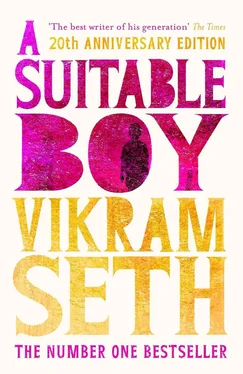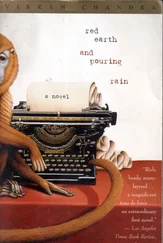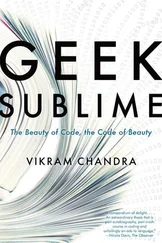Vikram Seth - A Suitable Boy
Здесь есть возможность читать онлайн «Vikram Seth - A Suitable Boy» весь текст электронной книги совершенно бесплатно (целиком полную версию без сокращений). В некоторых случаях можно слушать аудио, скачать через торрент в формате fb2 и присутствует краткое содержание. Год выпуска: 2012, Издательство: Orion Publishing Co, Жанр: Современная проза, на английском языке. Описание произведения, (предисловие) а так же отзывы посетителей доступны на портале библиотеки ЛибКат.
- Название:A Suitable Boy
- Автор:
- Издательство:Orion Publishing Co
- Жанр:
- Год:2012
- ISBN:нет данных
- Рейтинг книги:5 / 5. Голосов: 1
-
Избранное:Добавить в избранное
- Отзывы:
-
Ваша оценка:
- 100
- 1
- 2
- 3
- 4
- 5
A Suitable Boy: краткое содержание, описание и аннотация
Предлагаем к чтению аннотацию, описание, краткое содержание или предисловие (зависит от того, что написал сам автор книги «A Suitable Boy»). Если вы не нашли необходимую информацию о книге — напишите в комментариях, мы постараемся отыскать её.
A Suitable Boy — читать онлайн бесплатно полную книгу (весь текст) целиком
Ниже представлен текст книги, разбитый по страницам. Система сохранения места последней прочитанной страницы, позволяет с удобством читать онлайн бесплатно книгу «A Suitable Boy», без необходимости каждый раз заново искать на чём Вы остановились. Поставьте закладку, и сможете в любой момент перейти на страницу, на которой закончили чтение.
Интервал:
Закладка:
‘Take those shoes off,’ he said to Sunil. ‘I want them back.’
‘You swine!’ said Sunil. ‘Just because I happened to mention the holiest of holies. . ’
‘You donkey,’ replied Haresh. ‘I’m not going to eat them — I’ll give them back to you in a few days.’
‘What are you going to do with them?’
‘You’d be bored if I told you. Come on, take them off.’
‘What, now?’
‘Yes, why not? A few drinks later I’ll have forgotten and you’ll have gone off to sleep with them on.’
‘Oh, all right!’ said Sunil obligingly and took off his shoes.
‘That’s better,’ said Haresh. ‘It’s brought you an inch closer to my height. What glorious socks,’ he added, as Sunil’s bright red cotton tartan socks came more fully into view.
‘Wah! wah!’ There were cries of approval from all sides.
‘What beautiful ankles,’ continued Haresh. ‘Let’s have a performance!’
‘Light the chandeliers,’ cried someone.
‘Bring out the emerald goblets.’
‘Sprinkle the attar of roses.’
‘Lay a white sheet on the floor and charge an entrance fee!’
The young historian, in the affected tones of an official announcer, informed the audience: ‘The famous courtesan Sunil Patwardhan will now perform for us her exquisite rendering of the kathak dance. Lord Krishna is dancing with the milkmaids. “Come,” he says to the gopis, “come to me. What is there to fear?”’
‘Tha-tha-thai-thai!’ said a drunken physicist, imitating the sound of the dance steps.
‘Not courtesan, you lout, artiste!’
‘Artiste!’ said the historian, prolonging the last vowel.
‘Come on, Sunil — we’re waiting.’
And Sunil, obliging fellow that he was, danced a few clumpish steps of quasi-kathak while his friends rolled around with laughter. He simpered coyly as he twirled his chubby bulk about the room, knocking a book down here and spilling someone’s drink there. He then became completely engrossed in what he was doing, and followed his rendition of Krishna and the gopis — in which he played both parts — with an impromptu scene representing the Vice-Chancellor of Brahmpur University (a notorious and indiscriminate womanizer) oilily greeting the poet Sarojini Naidu when she came as the chief guest at the Annual Day ceremonies. Some of his friends, helpless with laughter, begged him to stop, and others, equally helpless, begged him to dance forever.
4.7
Into this scene walked a tall, white-haired gentleman, Dr Durrani. He was mildly surprised to see what was going on inside. Sunil froze in mid-dance, indeed in mid-stance — but then went forward to greet his unexpected guest.
Dr Durrani was not as surprised as he should have been; a mathematical problem was occupying the larger part of his cerebrum. He had decided to walk over and discuss it with his young colleague. In fact it had been Sunil who had given him the impetus for his idea in the first place.
‘Er, I, have I, er, chosen a bad time — er—?’ he asked in his maddeningly slow voice.
‘Well, no — not, er, exactly—’ said Sunil. He liked Dr Durrani and was somewhat in awe of him. Dr Durrani was one of the two Fellows of the Royal Society that Brahmpur University could boast of, the other being Professor Ramaswami, the well-known physicist.
Dr Durrani did not even notice that Sunil was imitating his manner of speech; Sunil himself was still in an imitative mode after his kathak performance, and only noticed it himself after he had done it.
‘Er, well, Patwardhan, er, I do feel that, perhaps, I am, er, impinging?’ continued Dr Durrani. He had a strong square face, with a handsome white moustache, but scrunched up his eyes for punctuation every time he said ‘er’. This syllable also caused his eyebrows and the lower part of the skin on his forehead to move up and down.
‘No, no, Dr Durrani, of course not. Please do join us.’ Sunil led Dr Durrani to the centre of the room, planning to introduce him to the other guests. Dr Durrani and Sunil Patwardhan were a study in physical contrast despite the fact that they were both rather tall.
‘Well, if you are, er, certain, you know, that I’m not going to, er, er, be in the way. You see,’ went on Dr Durrani more fluently but just as slowly, ‘what has been troubling me for the last day or so is this question of what you might call, er, super-operations. I — well, I — you see, I, um, thought that on the basis of all that, we could come up with several quite surprising series: you see, er—’
Such was the force of Dr Durrani’s innocent involvement in his magical world, and so uncensorious was he about the indecorous high jinks of his juniors, that they did not seem greatly put out by the fact that he had intruded on their evening.
‘Now you see, Patwardhan,’—Dr Durrani treated the whole world on terms of gentle distance—‘it isn’t just a question of 1, 3, 6, 10, 15—which would be a, er, trivial series based on the, er, primary combinative operation — or even 1, 2, 6, 24, 120—which would be based on the secondary combinative operation. It could go much, er, much further. The tertiary combinative operation would result in 1, 2, 9, 262144, and then 5 to the power of 262144. And of course that only, er, takes us to the fifth term in the, er, third such operation. Where will the, er, where will the steepness end?’ He looked both excited and distressed.
‘Ah,’ said Sunil, his whisky-rich mind not quite on the problem.
‘But of course what I am saying is, er, quite obvious. I didn’t mean to, er, er, trouble you with that. But I did think that I, er,’—he looked around the room, his eye alighting on a cuckoo clock on the wall—‘that I would, well, pick your brains on something that might be quite, er, quite unintuitive. Now take 1, 4, 216, 72576 and so on. Does that surprise you?’
‘Well—’ said Sunil.
‘Ah!’ said Dr Durrani, ‘I thought not.’ He looked approvingly at his younger colleague, whose brains he often picked in this manner. ‘Well, well, well! Now shall I tell you what the impetus, the, er, catalyst, for all this, was?’
‘Oh, please do,’ said Sunil.
‘It was a, er, a remark — a very, er, perceptive remark of yours.’
‘Ah!’
‘You said, apropos the Pergolesi Lemma, “The concept will form a tree.” It was a, er, a brilliant comment — I never thought of it in those terms before.’
‘Oh—’ said Sunil.
Haresh winked at him, but Sunil frowned. Making deliberate fun of Dr Durrani was lese-majesty in his eyes.
‘And indeed,’ went on Dr Durrani generously, ‘though I was, er, blind to it at the time’—he scrunched up his deep-set eyes almost into nothingness by way of unconscious illustration—‘it, well, it does form a tree. An unprunable one.’
He saw in his mind’s eye a huge, proliferating, and — worst of all — uncontrollable banyan tree spreading over a flat landscape, and continued, with increasing distress and excitement: ‘Because whatever, er, method of super-operating is chosen — that is, type 1 or type 2—it cannot, er, it cannot definitely be applied at each, er, at each stage. To choose a particular, well, clumping of types may, may. . er, yes, it may indeed prune the branches but it will be too, er, arbitrary. The alternative will not yield a, er, consistent algorithm. So this, er, question arose in my, er, mind: how can one generalize it as one moves to higher operations?’ Dr Durrani, who tended to stoop slightly, now straightened up. Clearly, action was required in the face of these terrible uncertainties.
‘What conclusion did you come to?’ said Sunil, tottering a bit.
‘Oh, but that is just it. I didn’t. Of course, er, super-operation n+1 has to act vis-à-vis super-operation n as n acts to n–1. That goes without saying. What troubles me is, er, the question of iteration. Does the same sub-operation, the same, er, sub-super-operation, if I might call it that’—he smiled at the thought of his terminology—‘does it, er — would it—’
Читать дальшеИнтервал:
Закладка:
Похожие книги на «A Suitable Boy»
Представляем Вашему вниманию похожие книги на «A Suitable Boy» списком для выбора. Мы отобрали схожую по названию и смыслу литературу в надежде предоставить читателям больше вариантов отыскать новые, интересные, ещё непрочитанные произведения.
Обсуждение, отзывы о книге «A Suitable Boy» и просто собственные мнения читателей. Оставьте ваши комментарии, напишите, что Вы думаете о произведении, его смысле или главных героях. Укажите что конкретно понравилось, а что нет, и почему Вы так считаете.











